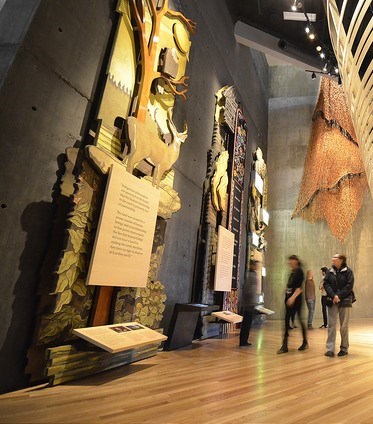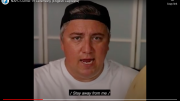Winnipeg – January 26, 2018 – As the 70th anniversary year of the Universal Declaration of Human Rights begins, voices of Indigenous youth across Canada have been shared through a new website, where they reflect on human rights and reconciliation
Video and artwork from the “Spirit Panel” project – which created visual and interactive exhibit elements for the Indigenous Perspectives gallery at the Canadian Museum for Human Rights (CMHR) in Winnipeg – can now be explored online. The project began in 2013 as a partnership between the National Association of Friendship Centres (NAFC) and the CMHR, involving workshops with Indigenous youth, artists and Elders held at Friendship Centres in every province and territory.
“This project highlights the important role of Friendship Centres as gathering places for both youth and Elders, where culture and creativity can mix in profound ways,” said NAFC President Christopher Sheppard. “I thank the young people and artists who shared so many pieces of themselves during this journey together.”
CMHR President and CEO John Young said digital outreach allows the museum to take human rights stories beyond its walls. “Sharing the perspectives of Indigenous youth is important for reconciliation in Canada and for human rights education in general.”
Online visitors can virtually examine the 13 artistic wooden Spirit Panels created by the Indigenous artists, inspired by discussions with youth at the workshops. In the Museum, the Spirit Panels adorn a circular theatre designed to resemble a woven basket, which plays a 360-degree surround film sharing perspectives on human rights narrated by four generations of Indigenous women and girls.
The new website also includes videos of Indigenous youth explaining their visions for human rights – equality, respect, honesty, freedom, the right to speak your own language, practice your culture and be free from discrimination. For example:
- “It’s time that we speak up for ourselves and get out of our comfort zones in a good way and tell our stories,” says one teenager in the video. “I think we all have a story to tell and talents to give.”
- “I shouldn’t have to face discrimination for being who I am,” says another. “I should be able to be proud and not have to feel ashamed of who I am as a person.”
Some express their frustration about limitations to fulfillment of their rights. For example:
- “We have treaty rights that aren’t being honoured and rights that are being taken away from our people on our own lands,” says one young woman.
- “We’ve learned your way of living,” says a young man, reading from artwork he created in the workshop. “Now it’s our turn to show you ours.”
During the project, Elders and artists engaged youth in ceremony, songs and sharing circles focused on conversation about rights and responsibilities from their own perspectives. The artists then led the group in hands-on visual art activities to creatively represent their thoughts and create a collective statement about human rights. Indigenous filmmaker Jordan Molaro documented the project and created videos from each community.
“There are many Indigenous youth who are engaged across the Friendship Centre Movement,” said the NAFC’s Aboriginal Youth Council president, Rae-Anne Harper. “They are committed to making change through civic engagement and many of their stories are being heard. This website will keep their perspectives and thoughts relevant and alive.”
The 2013 workshops were held in Whitehorse, Yukon with artist Ukjese Van Kampen; Behchoko, Northwest Territories with artist James Wedzin; Rankin Inlet, Nunavut with artist Veronique Nirlungayuk; Nanaimo, British Columbia with artist Joel Good; High Prairie, Alberta with artist Aaron Paquette; Prince Albert, Saskatchewan with artist Leah Dorian; Selkirk, Manitoba with artist Louis Ogemah; Toronto, Ontario with artist Scott Benesiinaabandan; Saguenay, Quebec with artist Sonia Robertson; Fredericton, New Brunswick with artist Alan Syliboy; Charlottetown, Prince Edward Island with artist Gilbert Alex Sark; Halifax, Nova Scotia with artist Ursula Johnson; and St. John’s, Newfoundland with artist Dinah Anderson.
The National Association of Friendship Centres (NAFC) is a network of 125 Friendship Centres and Provincial and Territorial Associations (PTAs) from coast-to-coast-to-coast. Friendship Centres are Canada’s most significant off-reserve Indigenous service delivery infrastructure and are the primary providers of culturally enhanced programs and services to urban Indigenous residents. For over half-a-century, Friendship Centres have been facilitating the transition of Indigenous people from rural, remote and reserve life to an urban environment. For many Indigenous people, Friendship Centres are the first point of contact to obtain referrals to cultural based socio-economic programs and services. See the NAFC website for more information at www.nafc.ca.
The Canadian Museum for Human Rights (CMHR) is the first museum in the world solely dedicated to the evolution, celebration and future of human rights. Located in Winnipeg, Manitoba, it is the first national museum in Canada to be established outside the National Capital Region. Using immersive multi-media technology and other innovative approaches, the Museum creates inspiring encounters with human rights as part of a visitor experience unlike any other. Learn more at www.humanrights.ca.




Be the first to comment on "Voices of Indigenous youth shared online in cross-Canada project"